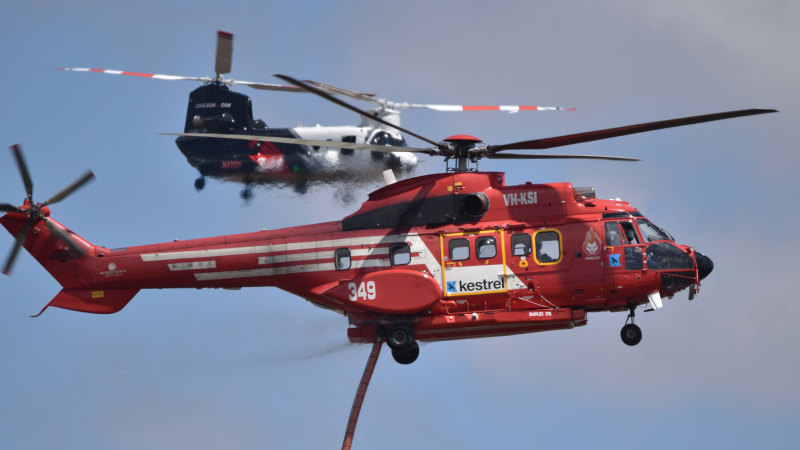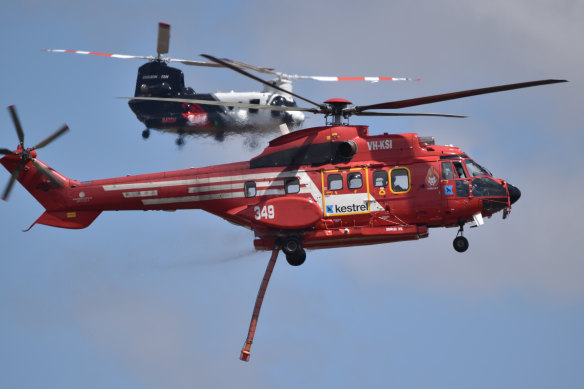Save articles for later
Add articles to your saved list and come back to them any time.
Victoria’s water bombing capabilities have been slashed by almost a third as emergency responders, pilots and experts warn that Victoria may not be prepared for the hot and dry summer ahead.
Leaked documents from Emergency Management Victoria obtained by The Age and 3AW, along with data from the National Aerial Firefighting Centre, which manages contracts for most states, reveals Victoria’s total aerial firefighting capability has fallen about 40,000 litres below last summer’s level.
A Kestrel Aviation Super Puma Helitak 349 firebombing helicopter in front of a Coulson Aviation CH-47D Chinook helicopter in Victoria.Credit: Brian Wilson
The capacity is now about 105,000 litres, which would force aircraft to take more flights and cost critical time during a hot and dry fire season. The Bureau of Meteorology has warned that the return of El Niño conditions in coming months is “likely” and experts believe grass fires would be a major risk this year.
The royal commission into the Black Summer fires, which killed 33 people, in 2020 called on governments to expand aerial firefighting fleets because longer fire seasons meant jurisdictions had less capacity to share resources.
Wildfires in Hawaii this week became the deadliest in the United States for more than a century, killing more than 100.
Half a dozen sources working within the emergency management sector, including pilots and senior commanders not authorised to speak publicly, said surge capacity was going backwards with diminishing ability to share aircraft.
Former emergency manager commissioner Craig Lapsley said aerial firefighting was becoming increasingly important.
“Aerial resources are becoming more critical in firefighting,” he said. “To me, it’s not the right time to be reducing resources.”
There are 32 Victorian-based aircraft able to drop water or retardant, according to the contract data. Fourteen other aircraft committed to Victoria for firefighting do not have water bombing capabilities. Last year there were 38 aircraft capable of water bombing and in 2021-22 there were 40.
Victoria will also be without the Chinook helicopter, a former military helicopter used for the last two summers, after a bitter contract dispute between the operator and the state government, an air attack pilot said on condition of anonymity out of fear of retribution.
The pilot said Victoria had stalled its use of night water bombing, which allowed large blazes to build in severity overnight. Just two low-capacity helicopters would be running trials this summer.
The Victorian government broadly supported all the recommendations from the Royal Commission into National Natural Disaster Arrangements and in 2021 said it would “continue to evaluate our aerial firefighting capability”.
Fire science professor David Bowman, from the University of Tasmania, said there had been little progress nationwide on the commission’s 80 recommendations.
While aerial firefighting was a necessary aspect of fire preparedness, he said it was often viewed as a politically expedient, magical solution. He said Australia and the states should be spending more on preventative measures through communities and fuel load management.
“You need aerial firefighting, that’s a fact,” Bowman said. “But not at the expense of everything else.
“They’re not even doing that bit, which is politically the simplest. You can understand why fire scientists are depressed and shaking their heads in disbelief.”
Bowman said Victoria had led the way on fire bunkers, as the first state to have a formal accreditation system and which saved lives in the 2019-20 fires.
Neil Bibby, a former chief executive of the Country Fire Authority, said there were issues with the Victorian approach, but criticism based purely on water carrying capacity was misguided.
The smartest approach, he said, was rapid responses using small helicopters to extinguish a blaze before it developed, and that satellite technology existed to help pinpoint a fire early.
“It’s got nothing to do with the amount of water we carry. It’s how we use the water that’s important,” said Bibby, who is also the editor of the Australian Pacific Fire Magazine.
“Traditionally, what we’ve been doing is waiting for a big fire to occur, then throwing big helicopters, big aircraft at it, the whole lot … It’s a dumb thing to say, but if you put a fire out early, you haven’t got a problem.”
The state Department of Energy, Environment and Climate Action has been consulting the community to develop its bushfire management strategy for the next 10 years, and warns that fire seasons were becoming longer and mega-fires were increasingly prevalent due to climate change.
The consultation document said an aircraft fleet should support on-ground firefighters to detect, suppress and gather intelligence and provide rapid transport.
Environment Minister Ingrid Stitt told the Victorian Parliament on Thursday that the state did 234 planned burns in 2022-23 and another 18 have been done since July 1.
An Emergency Management Victoria spokeswoman said the state was well-prepared for the high-risk fire period and that aircraft would play a key role supporting emergency services on the ground.
“Victoria’s aerial firefighting fleet comes online progressively across the state, according to risk,” she said.
“There is no reduction in the number of firebombing aircraft in Victoria this year compared to last year. Procurement of the fleet is still under way and will be finalised shortly.”
The sources who spoke to The Age and 3AW said there were limited aircraft still left available to procure because of supply chain blockages that would put Victoria behind. Pilot shortages would also suppress surge capacity, they said.
The Morning Edition newsletter is our guide to the day’s most important and interesting stories, analysis and insights. Sign up here.
Most Viewed in Politics
From our partners
Source: Read Full Article

